A New Synchronous Handling Technology of Double Stack Container Trains in Sea-Rail Intermodal Terminals
Abstract
:1. Introduction
2. Literature Review
3. Optimization Design of Synchronous Handling Technology
3.1. Innovative Design of Equipment
3.1.1. Design of LDAGV
3.1.2. Optimization Design of a Special Double-Stack Container Articulated Flat Car
3.2. Optimization of the Yard and Wharf Layout
3.2.1. Design of the Double-Stack Yard Area
3.2.2. General Layout and Operation Process of the Terminal
4. Implementation and Evaluation of the Scheme
4.1. Stacking Forms for Containers on Double-Stack Container Articulated Flat Car
4.2. Evaluation of the Program under Transportation Limits and Height Requirements of the Center of Gravity
5. Cost-Benefit Analysis
5.1. Data Preparation
5.2. Calculation of Handling Time and Operation Cost
5.3. Case Analysis
6. Conclusions
- In this study, a new articulated flat car is developed, which is designed with two-tier bearing platforms to load containers on the upper and lower layers at the same time without affecting each other. This will not only help to increase the number of containers loaded and shipped but will also accelerate the loading and unloading speed. Additionally, eight feasible container stacking modes are realized on the new special articulated flat car of double-stack container trains, which is conducive to mixing and matching different types of containers to reduce the difficulty of making loading plans and organizing the containers and the cargo source.
- At the same time, on the basis of traditional AGV, a new type of electric-powered LDAGV is designed. It can not only transport containers between the yard and the quayside container crane, between the yard and the railway platform, and between the quayside container crane and the railway platform, but it can also load the containers onto the new special articulated flat car without the help of rail cranes, tire cranes, reach stackrs, or forklifts, thus reducing the purchase and use costs of these machines.
- To cooperate with the work of LDAGV and the new special articulated flat car, a new concept of double-tier container yard and double-tier stereoscopic yard used in wharfs and inland railway freight stations is proposed. This can improve the utilization of the container yard and facilitate the loading and unloading of containers on or off double-stack container trains.
- The process of containers from the liner ship to the inland railway container freight station is described in detail, and the loading, unloading and transfer procedure of double-stack container trains at the wharf and the railway freight station are optimized.
- With the help of a scientific and reasonable case analysis, it is shown that the new synchronous handling technology for double-stack container trains is helpful in reducing the handling time and operation cost in the port.
- The application of this new technology is beneficial to improving port collection and distribution capacity, which is conducive to a reduction in the backlog time of containers in ports to ease the pressure of port congestion.
Author Contributions
Funding
Institutional Review Board Statement
Informed Consent Statement
Data Availability Statement
Conflicts of Interest
References
- Gharehgozli, A.H.; Roy, D.; De Koster, R. Sea Container Terminals: New Technologies and OR Models. Marit. Econ. Logist. 2016, 18, 103–140. [Google Scholar] [CrossRef]
- Vis, I.F.A.; De Koster, R. Transshipment of Containers at a Container Terminal: An Overview. Eur. J. Oper. Res. 2003, 147, 1–16. [Google Scholar] [CrossRef]
- Schepler, X.; Balev, S.; Michel, S.; Sanlaville, É. Global Planning in a Multi-Terminal and Multi-Modal Maritime Container Port. Transp. Res. Part E Logist. Transp. Rev. 2017, 100, 38–62. [Google Scholar] [CrossRef]
- Corry, P.; Kozan, E. Optimised Loading Patterns for Intermodal Trains. OR Spectr. 2008, 30, 721–750. [Google Scholar] [CrossRef]
- Wang, W.F.; Yun, W.Y. Scheduling for Inland Container Truck and Train Transportation. Int. J. Prod. Econ. 2013, 143, 349–356. [Google Scholar] [CrossRef]
- Chang, Y.M.; Zhu, X.N.; Haghani, A. The Outbound Container Slot Allocation Based on the Stowage Plan in Rail–Water Intermodal Container Terminals. Meas. Control 2019, 52, 509–525. [Google Scholar] [CrossRef]
- Rodriguez-Molins, M.; Salido, M.A.; Barber, F. Intelligent Planning for Allocating Containers in Maritime Terminals. Expert Syst. Appl. 2012, 39, 978–989. [Google Scholar] [CrossRef]
- Upadhyay, A. Improving Intermodal Train Operations in Indian Railways. Inf. J. Appl. Anal. 2020, 50, 213–224. [Google Scholar] [CrossRef]
- Yan, B.C.; Jin, J.G.; Zhu, X.N.; Lee, D.-H.; Wang, L.; Wang, H. Integrated Planning of Train Schedule Template and Container Transshipment Operation in Seaport Railway Terminals. Transp. Res. Part E Logist. Transp. Rev. 2020, 142, 102061. [Google Scholar] [CrossRef]
- Schulz, A.; Fliedner, M.; Fiedrich, B.; Pfeiffer, C. Levelling Crane Workload in Multi-Yard Rail-Road Container Terminals. Eur. J. Oper. Res. 2021, 293, 941–954. [Google Scholar] [CrossRef]
- Luo, T.; Chang, D.F.; Gao, Y.P. Optimization of Gantry Crane Scheduling in Container Sea-Rail Intermodal Transport Yard. Math. Probl. Eng. 2018, 2018, 9585294. [Google Scholar] [CrossRef]
- Luo, J.B.; Wu, Y. Scheduling of Container-Handling Equipment during the Loading Process at an Automated Container Terminal. Comput. Ind. Eng. 2020, 149, 106848. [Google Scholar] [CrossRef]
- Ambrosino, D.; Siri, S. Comparison of Solution Approaches for the Train Load Planning Problem in Seaport Terminals. Transp. Res. Part E Logist. Transp. Rev. 2015, 79, 65–82. [Google Scholar] [CrossRef]
- Heggen, H. Optimising Load Planning and Container Routing in Intermodal Rail Transport. 4OR 2020, 18, 127–128. [Google Scholar] [CrossRef]
- Tschöke, M.; Boysen, N. Container Supply with Multi-Trailer Trucks: Parking Strategies to Speed up the Gantry Crane-Based Loading of Freight Trains in Rail Yards. OR Spectr. 2018, 40, 319–339. [Google Scholar] [CrossRef]
- Bruns, F.; Goerigk, M.; Knust, S.; Schöbel, A. Robust Load Planning of Trains in Intermodal Transportation. OR Spectr. 2014, 36, 631–668. [Google Scholar] [CrossRef]
- Guo, S.J.; Diao, C.J.; Li, G.; Takahashi, K. The Two-Echelon Dual-Channel Models for the Intermodal Container Terminals of the China Railway Express Considering Container Accumulation Modes. Sustainability 2021, 13, 2806. [Google Scholar] [CrossRef]
- Yan, B.C.; Zhu, X.N.; Lee, D.-H.; Jin, J.G.; Wang, L. Transshipment Operations Optimization of Sea-Rail Intermodal Container in Seaport Rail Terminals. Comput. Ind. Eng. 2020, 141, 106296. [Google Scholar] [CrossRef]
- Lang, M.X.; Zhou, X.S.; Sun, Y. Multi-objective optimization for double stack train loading problem. J. Transp. Syst. Eng. Inf. Technol. 2015, 15, 94–100. [Google Scholar] [CrossRef]
- Ng, M.; Talley, W.K. Rail Intermodal Management at Marine Container Terminals: Loading Double Stack Trains. Transp. Res. Part C Emerg. Technol. 2020, 112, 252–259. [Google Scholar] [CrossRef]
- Upadhyay, A.; Gu, W.H.; Bolia, N. Optimal Loading of Double-Stack Container Trains. Transp. Res. Part E Logist. Transp. Rev. 2017, 107, 1–22. [Google Scholar] [CrossRef]
- Mantovani, S.; Morganti, G.; Umang, N.; Crainic, T.G.; Frejinger, E.; Larsen, E. The Load Planning Problem for Double-Stack Intermodal Trains. Eur. J. Oper. Res. 2018, 267, 107–119. [Google Scholar] [CrossRef]
- Zhang, R.; Li, J.; Jian, W.L. Study on the loading schemes of double-stack container trains between Shaoxing and Ningbo-Zhoushan Port. J. Transp. Syst. Eng. Inf. Technol. 2018, 18, 141–146. [Google Scholar] [CrossRef]
- Angeloudis, P.; Bell, M.G.H. An Uncertainty-Aware AGV Assignment Algorithm for Automated Container Terminals. Transp. Res. Part E Logist. Transp. Rev. 2010, 46, 354–366. [Google Scholar] [CrossRef]
- Briskorn, D.; Drexl, A.; Hartmann, S. Inventory-Based Dispatching of Automated Guided Vehicles on Container Terminals. OR Spectr. 2006, 28, 611–630. [Google Scholar] [CrossRef]
- Gharehgozli, A.; Zaerpour, N.; René de Koster, R. Container Terminal Layout Design: Transition and Future. Marit. Econ. Logist. 2020, 22, 610–639. [Google Scholar] [CrossRef]
- Lee, B.K.; Kim, K.H. Optimizing the Yard Layout in Container Terminals. OR Spectr. 2013, 35, 363–398. [Google Scholar] [CrossRef]
- Zaerpour, N.; Gharehgozli, A.; De Koster, R. Vertical Expansion: A Solution for Future Container Terminals. Transp. Sci. 2019, 53, 1235–1251. [Google Scholar] [CrossRef]
- Xia, M.J.; Zhao, N.; Mi, W.J. Storage Allocation in Automated Container Terminals: The Upper Level. Pol. Marit. Res. 2016, 23, 160–174. [Google Scholar] [CrossRef]
- Yu, H.; Ning, J.Z.; Wang, Y.; He, J.L.; Tan, C.M. Flexible Yard Management in Container Terminals for Uncertain Retrieving Sequence. Ocean Coast. Manag. 2021, 212, 105794. [Google Scholar] [CrossRef]
- Zhen, L. Container Yard Template Planning under Uncertain Maritime Market. Transp. Res. Part E Logist. Transp. Rev. 2014, 69, 199–217. [Google Scholar] [CrossRef]
- Zhang, C.Q.; Liu, J.Y.; Wan, Y.; Murty, K.G.; Linn, R.J. Storage Space Allocation in Container Terminals. Transp. Res. Part B Methodol. 2003, 37, 883–903. [Google Scholar] [CrossRef]
- Zhao, Z.B.; Liu, W. Design of “Zero Overturning Rate” Automatic Stereoscopic Yard and General Layout of Terminal. Port Waterw. Eng. 2022, 37–45. [Google Scholar] [CrossRef]
- Yu, H.; Deng, Y.Y.; Zhang, L.J.; Xiao, X.; Tan, C.M. Yard Operations and Management in Automated Container Terminals: A Review. Sustainability 2022, 14, 3419. [Google Scholar] [CrossRef]
- Bruns, F.; Knust, S.; Shakhlevich, N.V. Complexity Results for Storage Loading Problems with Stacking Constraints. Eur. J. Oper. Res. 2016, 249, 1074–1081. [Google Scholar] [CrossRef]
- Ambrosino, D.; Caballini, C.; Siri, S. A Mathematical Model to Evaluate Different Train Loading and Stacking Policies in a Container Terminal. Marit. Econ. Logist. 2013, 15, 292–308. [Google Scholar] [CrossRef]

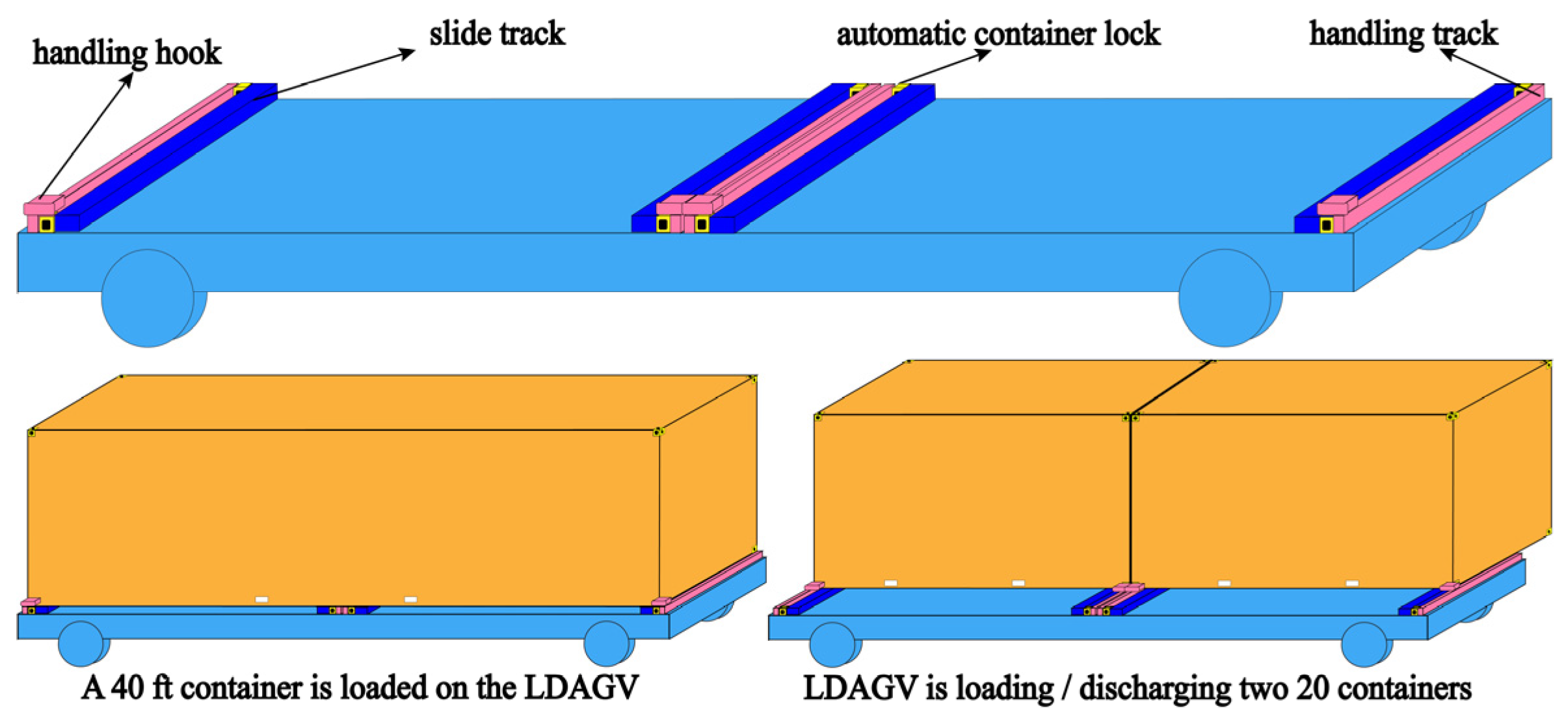
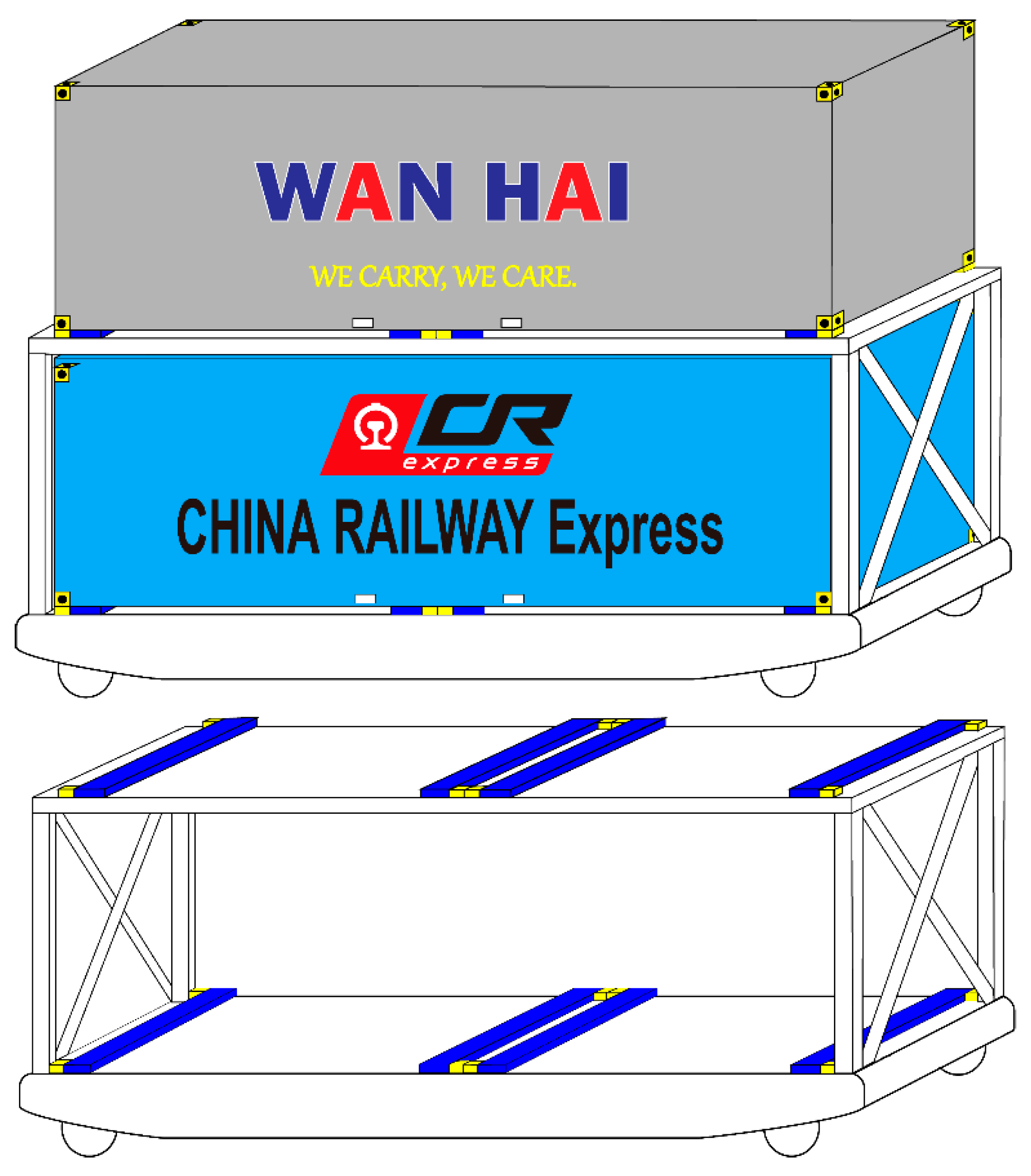
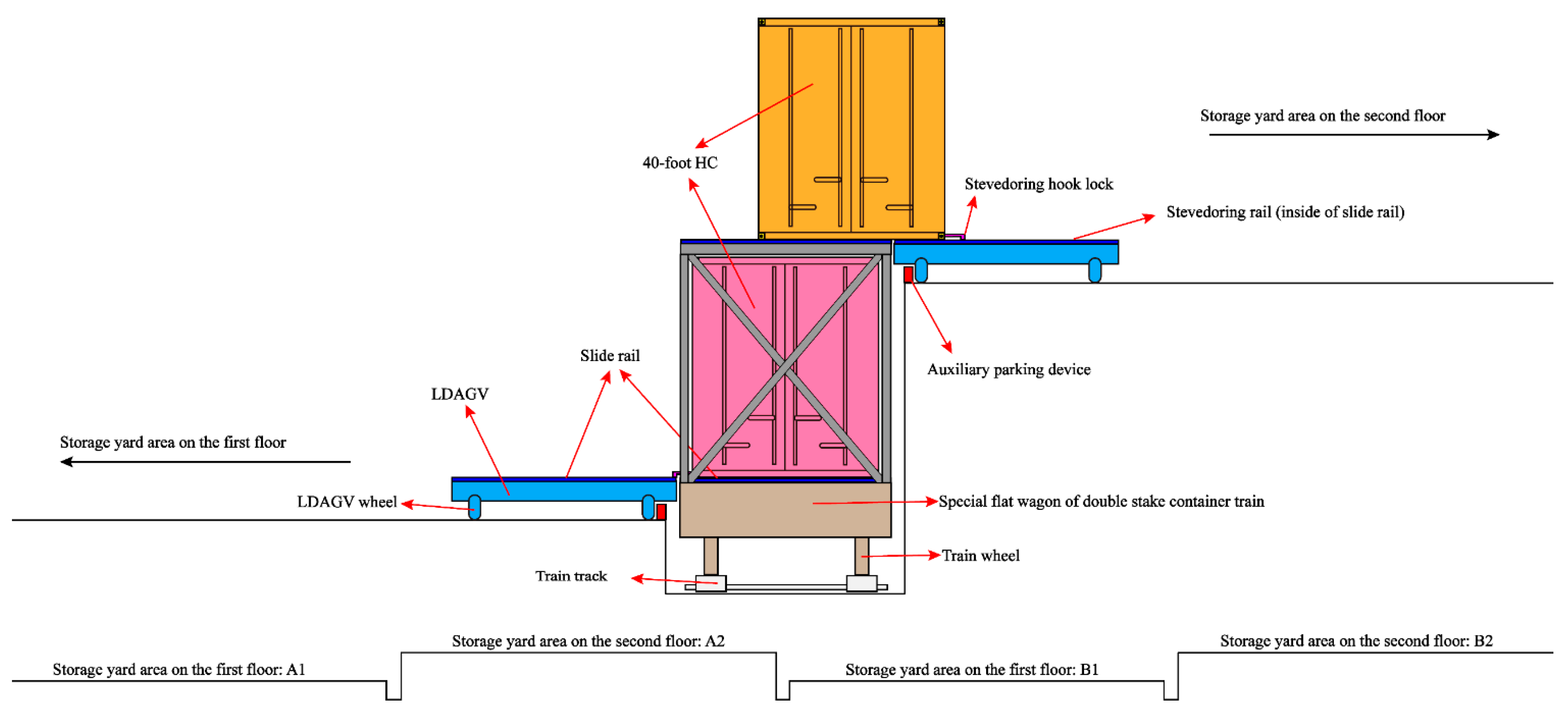
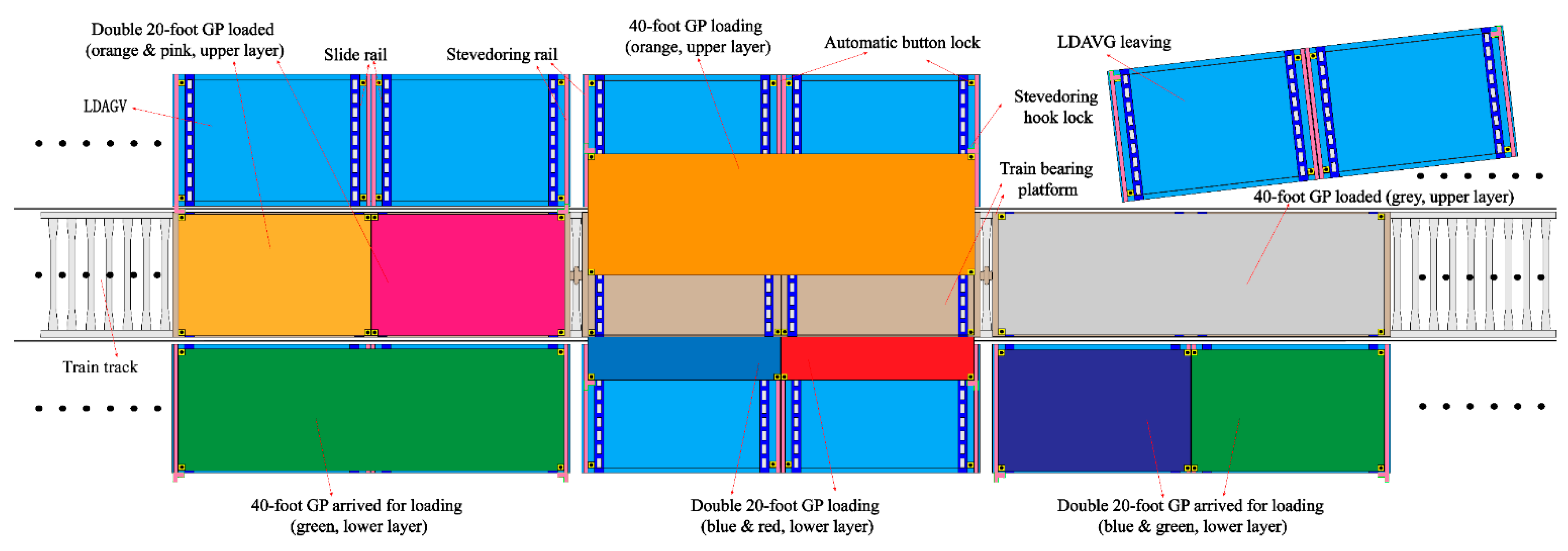
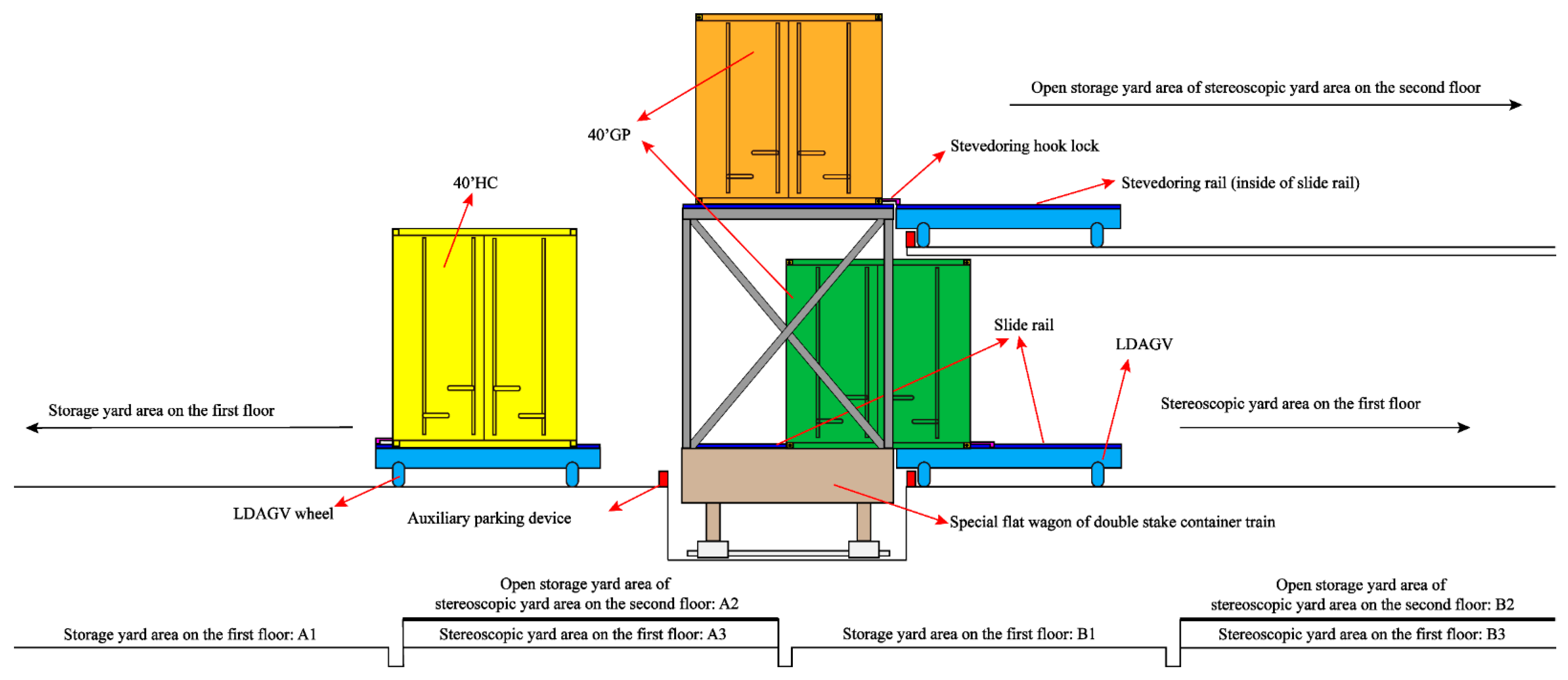

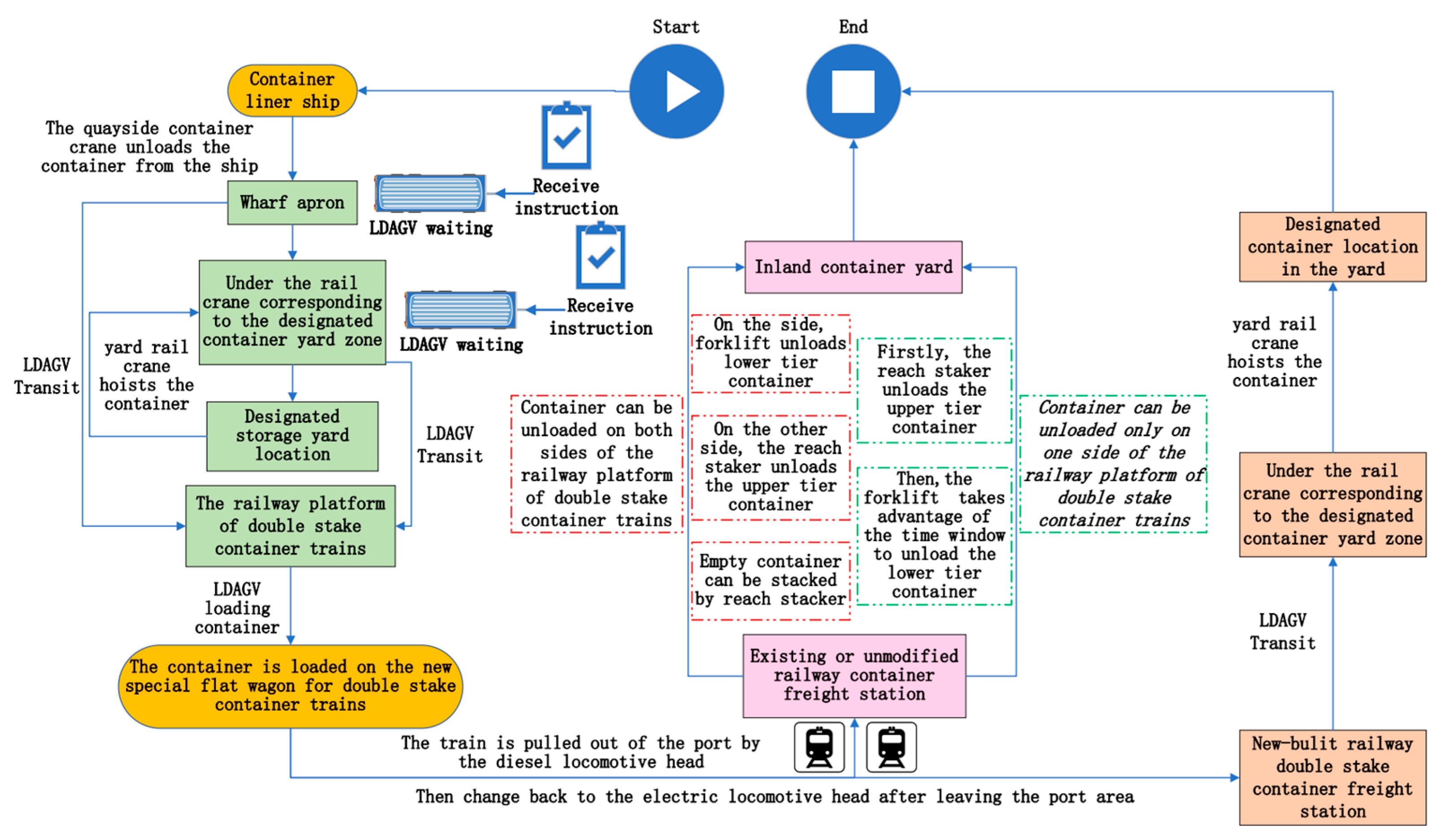

| Scheme Serial Number | Lower-Tier Stacking Form | Upper-Tier Stacking Form | Double-Tier Total Weight Requirements | Stack Type |
|---|---|---|---|---|
| A | 20-ft GP×2 | 20-ft GP×2 | 78 t | New form |
| B | 20-ft GP×2 | 40-ft GP | 78 t | Traditional form |
| C | 20-ft GP×2 | 40-ft HC | 78 t | Traditional form |
| D | 40-ft GP | 20-ft GP×2 | 78 t | New form |
| E | 40-ft GP | 40-ft GP | 61 t | New form |
| F | 40-ft GP | 40-ft HC | 61 t | New form |
| G | 40-ft HC | 20-ft GP×2 | 78 t | New form |
| H | 40-ft HC | 40-ft GP | 61 t | New form |
| I | 40-ft HC | 40-ft HC | 61 t | New form |
| Stacking Form | Gauge Height after Container Loading | Clearance Height after Considering Catenary Conductor |
|---|---|---|
| A | 5542 mm | 5942 mm |
| B | 5542 mm | 5942 mm |
| C | 5847 mm | 6247 mm |
| D | 5542 mm | 5942 mm |
| E | 5542 mm | 5942 mm |
| F | 5847 mm | 6247 mm |
| G | 5847 mm | 6247 mm |
| H | 5847 mm | 6247 mm |
| I | 6152 mm | 6552 mm |
| Scheme | Sequence | Segmented Operation Processes | Group ① Correction Time (min) | Group ② Correction Time (min) | Group ③ Correction Time (min) | Productivity/Speed |
|---|---|---|---|---|---|---|
| Traditional handling scheme for common double-stack container trains | 1 | Ship-(quayside gantry crane) -container truck | 3.9 | 7.8 | 5.85 | 40 natural container/h |
| 1* | Ship-(quayside gantry crane) -container truck | 3.9 | 7.8 | 5.85 | 40 natural container/h | |
| 2 | Wharf apron-(container truck) -yard | 2.34 | 2.34 | 2.34 | 20 km/h | |
| 2* | Wharf Apron-(container truck) -railway platform | 3.9 | 3.9 | 3.9 | 20 km/h | |
| 3 | Container truck-(yard tire crane) -container location | 7.8 | 15.6 | 11.7 | 20 natural container/h | |
| 4 | Container location-(yard tire crane)-container truck | 7.8 | 15.6 | 11.7 | 20 natural container/h | |
| 5 | Yard-(container truck) -railway platform | 1.56 | 1.56 | 1.56 | 20 km/h | |
| 6 | Container truck-(rail crane for train’s stevedoring) -ordinary articulated flat car | 6.24 | 12.48 | 9.36 | 25 natural container/h | |
| 6* | Container truck-(rail crane for train’s stevedoring) -ordinary articulated flat car | 6.24 | 12.48 | 9.36 | 25 natural container/h | |
| New synchronous handling scheme for double-stack container trains with new special articulated flat car | 1 | Container ship -(quayside gantry crane)-LDAGV | 3.9 | 7.8 | 5.85 | 40 natural container/h |
| 1* | Container ship-(quayside gantry crane)-LDAGV | 3.9 | 7.8 | 5.85 | 40 natural container/h | |
| 2 | Wharf apron-(LDAGV)-yard | 1.87 | 1.87 | 1.87 | 25 km/h | |
| 2* | Wharf apron-(LDAGV) -railway platform | 3.12 | 3.12 | 3.12 | 25 km/h | |
| 3 | LDAGV-(yard rail crane) -container location | 6.24 | 12.48 | 9.36 | 25 natural container/h | |
| 4 | Container location-(yard rail crane)-LDAGV | 6.24 | 12.48 | 9.36 | 25 natural container/h | |
| 5 | Yard-(LDAGV)-railway platform | 1.25 | 1.25 | 1.25 | 25 km/h | |
| 6 | LDAGV-(stevedoring device) -new special articulated flat car | 2.6 | 2.6 | 2.6 | 30 natural container/h | |
| 6* | LDAGV-(stevedoring device) -new special articulated flat car | 2.6 | 2.6 | 2.6 | 30 natural container/h |
| Scheme | Sequence | Total Power/Fuel Consumption | Group ① Operation Cost (RMB) | Group ② Operation Cost (RMB) | Group ③ Operation Cost (RMB) | Electricity Price/Oil Price |
|---|---|---|---|---|---|---|
| Traditional handling scheme for common double-stack container trains | 1 | 500 kw | 27.63 | 55.25 | 41.44 | 0.85 RMB/KWh |
| 1* | 500 kw | 27.63 | 55.25 | 41.44 | 0.85 RMB/KWh | |
| 2 | 0.32 L/km | 0.7 | 0.7 | 0.7 | 0.3KM (Diesel 7.25 RMB/L) | |
| 2* | 0.32 L/km | 1.16 | 1.16 | 1.16 | 0.5KM (Diesel 7.25 RMB/L) | |
| 3 | 210 kw | 23.21 | 46.41 | 34.81 | 0.85 RMB/KWh | |
| 4 | 210 kw | 23.21 | 46.41 | 34.81 | 0.85 RMB/KWh | |
| 5 | 0.32 L/km | 0.46 | 0.46 | 0.46 | 0.2KM (Diesel 7.25 RMB/L) | |
| 6 | 300 kw | 26.52 | 53.04 | 39.78 | 0.85 RMB/KWh | |
| 6* | 300 kw | 26.52 | 53.04 | 39.78 | 0.85 RMB/KWh | |
| New synchronous handling scheme for double-stack container trains with new special articulated flat car | 1 | 500 kw | 27.63 | 55.25 | 41.44 | 0.85 RMB/KWh |
| 1* | 500 kw | 27.63 | 55.25 | 41.44 | 0.85 RMB/KWh | |
| 2 | 200 kw | 5.3 | 5.3 | 5.3 | 0.3 KM (RMB/KWh) | |
| 2* | 200 kw | 8.84 | 8.84 | 8.84 | 0.5 KM (0.85 RMB/KWh) | |
| 3 | 300 kw | 26.52 | 53.04 | 39.78 | 0.85 RMB/KWh | |
| 4 | 300 kw | 26.52 | 53.04 | 39.78 | 0.85 RMB/KWh | |
| 5 | 200 kw | 3.54 | 3.54 | 3.54 | 0.2 KM (0.85 RMB/KWh) | |
| 6 | 100 kw | 3.68 | 3.68 | 3.68 | 0.85 RMB/KWh | |
| 6* | 100 kw | 3.68 | 3.68 | 3.68 | 0.85 RMB/KWh |
| Scheme | Mode | Unit Handling Time of Group ① (min) | Unit Handling Time of Group ② (min) | Unit Handling Time of Group ③ (min) | Unit Operation Cost of Group ① (RMB) | Unit Operation Cost of Group ② (RMB) | Unit Operation Cost of Group ③ (RMB) |
|---|---|---|---|---|---|---|---|
| Traditional handling scheme for common double-stack container trains | Normal mode | 29.64 | 55.38 | 42.51 | 101.73 | 202.27 | 152 |
| Direct access train-vessel mode | 14.04 | 24.18 | 19.11 | 55.31 | 109.45 | 82.38 | |
| New synchronous handling scheme for double-stack container trains with new special articulated flat car | Normal mode | 22.1 | 38.48 | 30.29 | 93.19 | 173.85 | 133.52 |
| Direct access train-vessel mode | 9.62 | 13.52 | 11.57 | 40.15 | 67.77 | 53.96 | |
| Time reduction in direct access train-vessel mode | 4.42 min | 10.66 min | 7.54 min | 31.48% | 44.09% | 39.46% | |
| Time reduction in normal mode | 7.54 min | 16.90 min | 12.22 min | 25.44% | 30.52% | 28.75% | |
| Cost reduction in direct access train-vessel mode | 15.16 RMB | 41.68 RMB | 28.42 RMB | 27.41% | 38.08% | 34.50% | |
| Cost reduction in normal mode | 8.54 RMB | 28.42 RMB | 18.48 RMB | 8.39% | 14.05% | 12.16% | |
| Project | Traditional Handling Scheme for Common Double-Stack Container Trains | New Synchronous Handling Scheme for Double-Stack Container Trains with New Special Articulated Flat Car | ||||
|---|---|---|---|---|---|---|
| Group ① | Group ② | Group ③ | Group ① | Group ② | Group ③ | |
| Number of units in direct access train-vessel mode | 500,000 FEU/2 =250,000 units | 1,500,000 TEU/4 =375,000 units | 500,000 FEU & 500,000 TEU =500,000 units | 500,000 FEU/2 =250,000 units | 1,500,000 TEU/4 =375,000 units | 500,000 FEU & 500,000 TEU =500,000 units |
| Number of units in normal mode | 1,500,000 FEU/2 =750,000 units | 4,500,000 TEU/4 =1,125,000 units | 1,500,000 FEU & 4,500,000 TEU =1,500,000 units | 1,500,000 FEU/2 =750,000 units | 4,500,000 TEU/4 =1,125,000 units | 1,500,000 FEU & 4,500,000 TEU =1,500,000 units |
| Process 1 | 20,722,500 | 62,156,250 | 62,160,000 | 20,722,500 | 62,156,250 | 62,160,000 |
| Process 1* | 6,907,500 | 20,718,750 | 20,720,000 | 6,907,500 | 20,718,750 | 20,720,000 |
| Process 2 | 525,000 | 787,500 | 1,050,000 | 3,975,000 | 5,962,500 | 7,950,000 |
| Process 2* | 290,000 | 435,000 | 580,000 | 2,210,000 | 3,315,000 | 4,420,000 |
| Process 3 | 17,407,500 | 52,211,250 | 52,215,000 | 19,890,000 | 60,795,000 | 59,670,000 |
| Process 4 | 17,407,500 | 52,211,250 | 52,215,000 | 19,890,000 | 60,795,000 | 59,670,000 |
| Process 5 | 345,000 | 517,500 | 690,000 | 2,655,000 | 3,982,500 | 5,310,000 |
| Process 6 | 19,890,000 | 59,670,000 | 59,670,000 | 2,760,000 | 4,140,000 | 5,520,000 |
| Process 6* | 6,630,000 | 19,890,000 | 19,890,000 | 920,000 | 1,380,000 | 1,840,000 |
| Cost in direct access train-vessel mode (RMB) | 13,827,500 | 41,043,750 | 41,190,000 | 10,037,500 | 25,413,750 | 26,980,000 |
| Cost in normal mode (RMB) | 76,297,500 | 227,553,750 | 228,000,000 | 69,892,500 | 197,831,250 | 200,280,000 |
| Total cost (RMB) | 90,125,000 | 268,597,500 | 269,190,000 | 79,930,000 | 223,245,000 | 227,260,000 |
| Cost reduction in direct access train-vessel mode | 3,790,000 RMB | 15,630,000 RMB | 14,210,000 RMB | 27.41% | 38.08% | 34.50% |
| Cost reduction in normal mode | 6,405,000 RMB | 29,722,500 RMB | 27,720,000 RMB | 8.39% | 13.06% | 12.16% |
| Total cost reduction | 10,195,000 RMB | 45,352,500 RMB | 41,930,000 RMB | 11.31% | 16.88% | 15.58% |
Publisher’s Note: MDPI stays neutral with regard to jurisdictional claims in published maps and institutional affiliations. |
© 2022 by the authors. Licensee MDPI, Basel, Switzerland. This article is an open access article distributed under the terms and conditions of the Creative Commons Attribution (CC BY) license (https://creativecommons.org/licenses/by/4.0/).
Share and Cite
Zhao, Z.; Wang, X.; Cheng, S.; Liu, W.; Jiang, L. A New Synchronous Handling Technology of Double Stack Container Trains in Sea-Rail Intermodal Terminals. Sustainability 2022, 14, 11254. https://doi.org/10.3390/su141811254
Zhao Z, Wang X, Cheng S, Liu W, Jiang L. A New Synchronous Handling Technology of Double Stack Container Trains in Sea-Rail Intermodal Terminals. Sustainability. 2022; 14(18):11254. https://doi.org/10.3390/su141811254
Chicago/Turabian StyleZhao, Zhongbin, Xifu Wang, Suxin Cheng, Wei Liu, and Lijun Jiang. 2022. "A New Synchronous Handling Technology of Double Stack Container Trains in Sea-Rail Intermodal Terminals" Sustainability 14, no. 18: 11254. https://doi.org/10.3390/su141811254
APA StyleZhao, Z., Wang, X., Cheng, S., Liu, W., & Jiang, L. (2022). A New Synchronous Handling Technology of Double Stack Container Trains in Sea-Rail Intermodal Terminals. Sustainability, 14(18), 11254. https://doi.org/10.3390/su141811254








